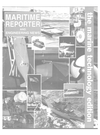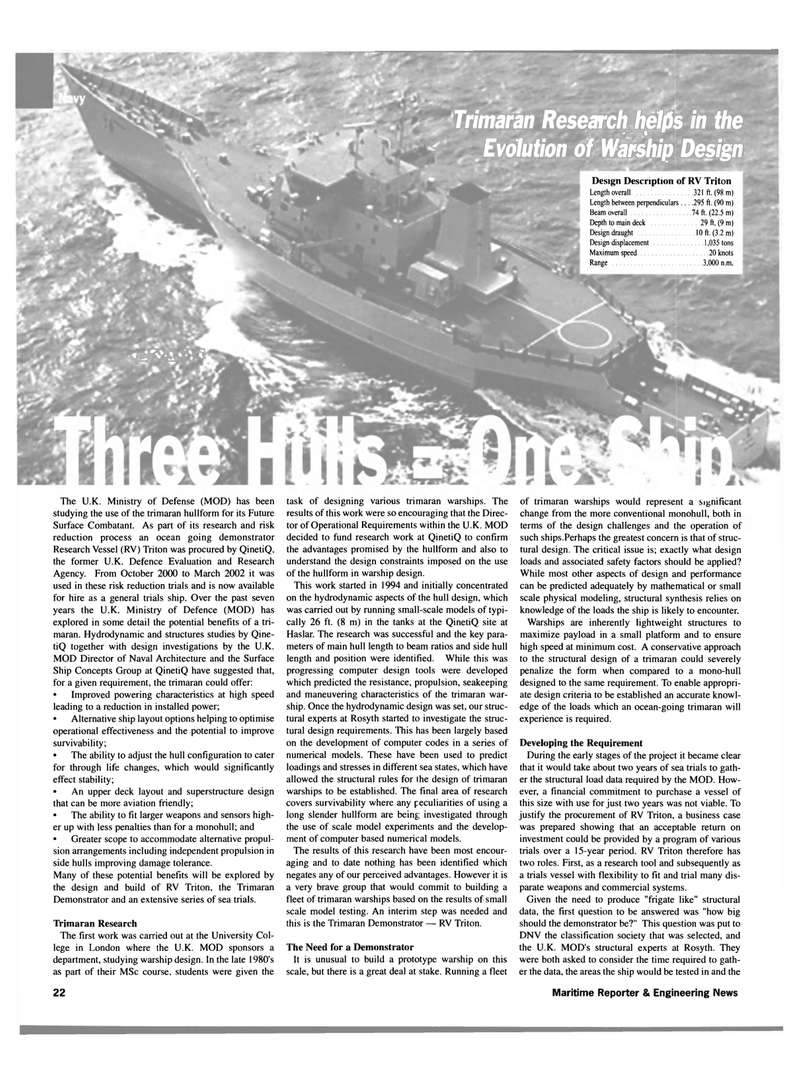
Page 22: of Maritime Reporter Magazine (September 2002)
Read this page in Pdf, Flash or Html5 edition of September 2002 Maritime Reporter Magazine
*i i
Trimaran Research helps in the * # n
Evolution of Warship Design lii*
Design Description of RV Triton
Length overall 321ft. (98 m)
Length between perpendiculars... .295 ft. (90 m)
Beam overall 74 ft. (22.5 m)
Depth to main deck 29 ft. (9 m)
Design draught 10ft. (3.2 m)
Design displacement 1,035 tons
Maximum speed 20 knots
Range 3,000 n.m.
The U.K. Ministry of Defense (MOD) has been studying the use of the trimaran hullform for its Future
Surface Combatant. As part of its research and risk reduction process an ocean going demonstrator
Research Vessel (RV) Triton was procured by QinetiQ, the former U.K. Defence Evaluation and Research
Agency. From October 2000 to March 2002 it was used in these risk reduction trials and is now available for hire as a general trials ship. Over the past seven years the U.K. Ministry of Defence (MOD) has explored in some detail the potential benefits of a tri- maran. Hydrodynamic and structures studies by Qine- tiQ together with design investigations by the U.K.
MOD Director of Naval Architecture and the Surface
Ship Concepts Group at QinetiQ have suggested that, for a given requirement, the trimaran could offer: • Improved powering characteristics at high speed leading to a reduction in installed power; • Alternative ship layout options helping to optimise operational effectiveness and the potential to improve survivability; • The ability to adjust the hull configuration to cater for through life changes, which would significantly effect stability; • An upper deck layout and superstructure design that can be more aviation friendly; • The ability to fit larger weapons and sensors high- er up with less penalties than for a monohull; and • Greater scope to accommodate alternative propul- sion arrangements including independent propulsion in side hulls improving damage tolerance.
Many of these potential benefits will be explored by the design and build of RV Triton, the Trimaran
Demonstrator and an extensive series of sea trials.
Trimaran Research
The first work was carried out at the University Col- lege in London where the U.K. MOD sponsors a department, studying warship design. In the late 1980's as part of their MSc course, students were given the task of designing various trimaran warships. The results of this work were so encouraging that the Direc- tor of Operational Requirements within the U.K. MOD decided to fund research work at QinetiQ to confirm the advantages promised by the hullform and also to understand the design constraints imposed on the use of the hullform in warship design.
This work started in 1994 and initially concentrated on the hydrodynamic aspects of the hull design, which was carried out by running small-scale models of typi- cally 26 ft. (8 m) in the tanks at the QinetiQ site at
Haslar. The research was successful and the key para- meters of main hull length to beam ratios and side hull length and position were identified. While this was progressing computer design tools were developed which predicted the resistance, propulsion, seakeeping and maneuvering characteristics of the trimaran war- ship. Once the hydrodynamic design was set, our struc- tural experts at Rosyth started to investigate the struc- tural design requirements. This has been largely based on the development of computer codes in a series of numerical models. These have been used to predict loadings and stresses in different sea states, which have allowed the structural rules for the design of trimaran warships to be established. The final area of research covers survivability where any peculiarities of using a long slender hullform are being investigated through the use of scale model experiments and the develop- ment of computer based numerical models.
The results of this research have been most encour- aging and to date nothing has been identified which negates any of our perceived advantages. However it is a very brave group that would commit to building a fleet of trimaran warships based on the results of small scale model testing. An interim step was needed and this is the Trimaran Demonstrator — RV Triton.
The Need for a Demonstrator
It is unusual to build a prototype warship on this scale, but there is a great deal at stake. Running a fleet of trimaran warships would represent a Significant change from the more conventional monohull, both in terms of the design challenges and the operation of such ships.Perhaps the greatest concern is that of struc- tural design. The critical issue is; exactly what design loads and associated safety factors should be applied?
While most other aspects of design and performance can be predicted adequately by mathematical or small scale physical modeling, structural synthesis relies on knowledge of the loads the ship is likely to encounter.
Warships are inherently lightweight structures to maximize payload in a small platform and to ensure high speed at minimum cost. A conservative approach to the structural design of a trimaran could severely penalize the form when compared to a mono-hull designed to the same requirement. To enable appropri- ate design criteria to be established an accurate knowl- edge of the loads which an ocean-going trimaran will experience is required.
Developing the Requirement
During the early stages of the project it became clear that it would take about two years of sea trials to gath- er the structural load data required by the MOD. How- ever, a financial commitment to purchase a vessel of this size with use for just two years was not viable. To justify the procurement of RV Triton, a business case was prepared showing that an acceptable return on investment could be provided by a program of various trials over a 15-year period. RV Triton therefore has two roles. First, as a research tool and subsequently as a trials vessel with flexibility to fit and trial many dis- parate weapons and commercial systems.
Given the need to produce "frigate like" structural data, the first question to be answered was "how big should the demonstrator be?" This question was put to
DNV the classification society that was selected, and the U.K. MOD's structural experts at Rosyth. They were both asked to consider the time required to gath- er the data, the areas the ship would be tested in and the 22 Maritime Reporter & Engineering News

 21
21

 23
23
